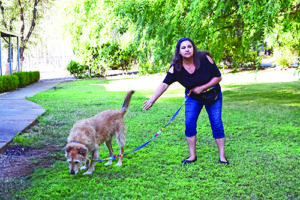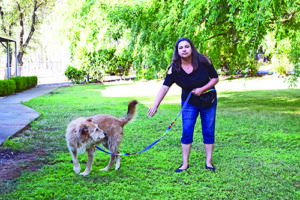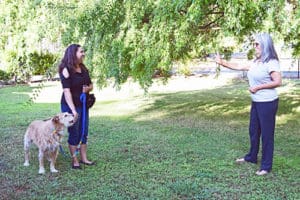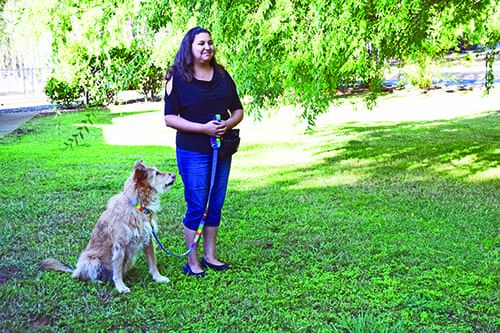Remember when you were a kid and your mom would catch you doing something you weren’t supposed to be doing, even though she wasn’t even looking at you? How did she do that? It was magic!
When we were little, we thought our parents must have eyes on the back of their heads, and this may well have influenced our behavior. We could never be certain that an authority figure like a parent or teacher couldn’t see what we were doing, so in order to avoid punishment we might try to be on our best behavior, just in case.

The same principle can be applied to positive reinforcement techniques. A child – or, in our case, a dog, can learn that he can be rewarded for good behavior even if the behavior takes place while a parent isn’t looking directly at him. Let’s consider how we can use this “magic” to obtain and hold our dog’s attention, even in the midst of some pretty exciting distractions.
WATCH ME WATCH YOU
You may have learned to reward your dog for looking at you or for tossing unprompted glances your way. This important behavior is often referred to as “checking in,” and I encourage everyone to reward it generously and frequently so that your dog learns to look to you for guidance in any number of situations. (See “Train Your Dog to ‘Check In,’” WDJ March 2017.)
When you’re teaching this basic skill, one element in particular easily stands out: Every time you reward your dog for checking in with you, you are also checking in with him. In other words, you are looking back at him.
While your dog’s attention is an excellent thing to reinforce, you can increase the power of the check-in behavior by adding just one more element of difficulty, which I will describe right after I explain why it’s worth your while to try.
Through training, most dogs learn to pay attention to us when we’re paying attention to them. They learn that when we’re focused on them, they have a very good chance of receiving some reinforcement. So they pay attention! They watch for cues, or they offer behaviors they know have been rewarding in the past. Clever pooches!
This is why when you practice the check-in behavior, you soon find you’ve got a dog staring at you or trying to get in front of you to make sure you can see them being a Very Good Dog.
But what happens after your attention is turned elsewhere? Well, most often, your dog goes back to whatever he was doing before, because “Oh, it seems we’re done here.” From your dog’s point of view, your lack of attention or eye contact usually means the opportunity for food or play has stopped.
If you’re working on a behavior that requires your dog’s attention, such as loose-leash walking (staying close to you rather than straining at the end of his leash to greet a person or another dog), you might find that as soon as you’re done delivering a treat and you turn your gaze away from your dog, he goes right back to doing the behavior you’re trying to eliminate. If you’re not looking at him, he’s off the hook and he disconnects. Take these scenarios, for example:
- You’re teaching your dog to stand politely next to you while you stop in the street to chat with someone. During training, as you stand with the other person, your eyes are on your dog as you reward him for good behavior. The session goes well and you end it. Later, when you think your dog has the behavior down pat, you stop and talk to someone. As your eyes and attention are focused on the person, not your dog, your dog jumps up on the person.
- You’re standing in line at a newsstand with your leashed dog by your side. You’re glancing at him often and he’s being a Very Good Dog as you reward him for good behavior. When it’s time to pay for your purchases and, just for a few moments, you turn your attention away from your dog and to the cashier, your dog starts to pull away, wanting to go check out something on the street a few feet away.
- You’re in a group training class and your dog is doing wonderfully while you’re working with him. As soon as you turn your attention toward the instructor who is speaking to the class, your dog turns his attention to Fifi, the cute little number who’s lying down quietly a short distance to the side.
These are just examples; you can probably think up more scenarios from your own experiences. What’s happening here is quite normal. If we only deliver rewards to our dogs when it’s clear we’re paying attention to them, then it stands to reason that they will figure out pretty quickly that if we’re not paying direct attention, there’s no possibility for reinforcement from us and they’re free to find it elsewhere, whether through social contact, getting to sniff around, or other important dog stuff.
Here’s a simple technique that can help you ensure that your dog becomes a pro at checking in with you – and maintaining that attentiveness – even when you’re not looking at him.
TREAT-DELIVERY WITH EYES FORWARD
The first exercise sounds easy enough, but it can actually be a bit of a challenge. It involves being with your dog on-leash and feeding him treats without ever looking at him – like, at all. Your attention will be focused on something else, anything else, as long as it’s not your dog. You can use your peripheral vision to steal glances if needed. You will:

1. Stand quietly with your dog in a low-distraction area. It can be in the heel position if this is important to you, but it’s not necessary for the purposes of this exercise.
2. Look forward or to the side, but don’t look at your dog.
3. Have some treats ready either in a pouch, a pocket, or in your hand. You can count on using about 15 treats for this exercise.

4. Feed one treat after another to your dog – blindly, without looking at him. Some dogs will remain close enough to you to make this easy. Some won’t and will already be wandering off somewhere (because he knows you’re not looking at him!). That’s why we want him on-leash, so he can’t get any farther than the length of the leash.
5. Don’t call him, don’t make kissy sounds, and don’t look at him, even if you feel him moving around. He’s not going anywhere, he’s on-leash. Use your peripheral vision to find him and feed him.
In a nutshell, you will be delivering free treats straight into your dog’s mouth without looking at him. Don’t peek! If you reach down and his muzzle isn’t there, use your peripheral vision and your hand to find it.

If your dog isn’t engaging at all, try either increasing the value of the treat, shortening the leash a little to keep him closer, or moving to a quieter space to decrease the level of stimuli in the environment. If you still have no luck, consider starting this exercise in a seated position (you, not your dog).
TREAT DELIVERY WITH EYES FORWARD and COUNTING FINGERS: MULTI TASKING SKILLS
This step is an adaptation of a brilliant educational nugget I picked up from the fabulous Emma Parsons at Clicker Expo in Washington, D.C., in the spring of 2019. I call it an adaptation because the original exercise incorporates the use of a clicker, where a clicker is clicked immediately before a treat is delivered. I don’t require the use of one, and in fact I prefer that nothing whatsoever gives the dog a hint as to when a treat will be made available to eat.
This exercise involves the blind treat-delivery skill (described above), and it throws in an extra-special feature: Counting fingers while you continue to feed your dog.
The blind feeding and the counting tasks are not connected at all. There is no order or sequence between the two activities. The counting is just an extra activity for you to practice in order to develop and refine your ability to multi-task.
Before you take on this added level of difficulty, however, make sure your blind feeding skills are super solid, because the last thing you want to do is lose your dog’s attention. Here’s what the exercise will look like:
1 Set yourself up as you did in the previous exercise: You have your dog, on-leash, and a handful of treats in a low-distraction area.
2. Start blind feeding your dog, like you were doing above. Deliver the treats in a steady, calm manner.
3. Have someone stand several feet in front of you where you can clearly see them, and ask them to flash random fingers from one hand in a steady, rhythmic fashion. You will announce how many fingers they are holding up at the same time that you are busy feeding your dog the treats.

In other words, it’s not a matter of calling out a number then feeding a treat, calling out the next number and feeding a treat, etc. They are completely separate events occurring randomly. What you’re aiming for is being able to feed your dog continuously and also once in a while calling out a number you see before you. There is no loop, no predictable sequence. You’re training yourself to multi-task.
Part of your brain should be busy feeding your dog without looking at him. The other part should be engaged with counting fingers and saying the numbers out loud. One activity could be proceeding at a faster speed than the other; they are two distinctly different things for you to focus on.
Why? Because in real life with your dog, you are focused on many different things at once. If your attention is super-focused on something other than your dog, like using the ATM machine or keeping an eye on those off-leash dogs heading your way, you need to be able to teach your dog to stay connected with you nonetheless (and maintain that behavior over time).
As a bonus, you’ll note that through these exercises, you are indirectly teaching a type of “stationing behavior” whereby your dog learns to stay close if you’re standing still. He also learns to be aware of your movements while on-leash. This type of attention is especially handy in a crowded area or under very exciting conditions like an activity where there are lots of other dogs.
As an additional and unexpected bonus, I can almost guarantee you will laugh and giggle through many of these practice sessions. It’s the dog-training equivalent of rubbing your tummy and tapping the top of your head at the same time. Enjoy the process, and reap the rewards when you finally have a dog who checks in with you even when your attention is elsewhere!





